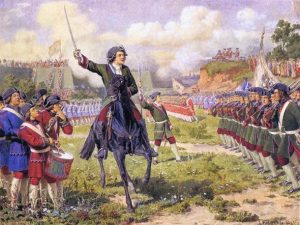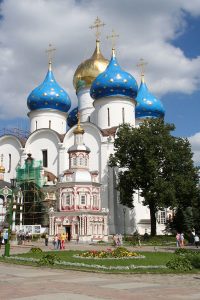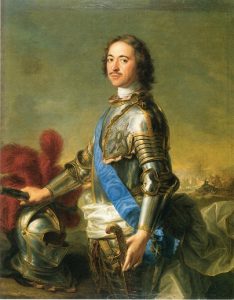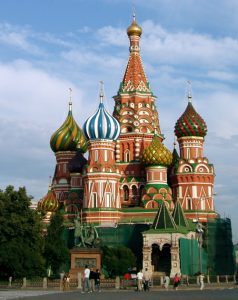
Image by David Crawshaw
Dangerous winds are blowing from Russia and they have nothing to do with Facebook, Mark Zuckerberg, or the 2016 American elections. It is in fact dangerously laughable that our elected representatives view Russia through that ridiculously myopic and self-referential lens. No, the real danger lies in what appears to be a de-facto answer that is now presenting itself to the question what kind of Russia will Putin’s Russia be.
In its roughly thousand-year history, Russia went through a number of phases. Prior to Peter the Great’s reign in early 18th century it was a shuttered woodland and steppe kingdom almost unknown in Europe and intentionally so. At that time, Russia was a very deeply religious kingdom that would have seemed quite exotic even to its contemporaries. Limited external trade, mostly in trapped fur and lumber was maintained and Ivan the Terrible sent a famous diplomatic mission to Queen Elizabeth I in Shakespeare’s lifetime. Mostly however, Russia, with its mix of Byzantine and Mongolian cultures sitting on ancient Norsemen foundations busied itself with an eastward expansion, pushing against islands of recently islamicized remnants of the Mongol Golden Horde such as the Khanate of Kazan and subduing the indigenous Inuit-like peoples of Siberia.
Putin Visits The Rogozhsky Old Believers’ Spiritual Center In Moscow First Time In 350 Years
Things did not always go smoothly, but the Kingdom of Muscovy, as Russia was then known amassed tremendous wealth from its vast natural resources. The mini ice age of the late Middle Ages created in Europe an insatiable demand for furs, a demand that Russia, with its access to the enormous boreal forests of Siberia and later even Alaska was happy to supply. Moscow’s wooden basilicas acquired golden shrouds and several boyar families became fabulously wealthy by any standard. With all its wealth, Russia neglected to invest in military technology; in stark contrast to its Western European neighbors it had no standing army as late as the end of the 17th century. The “streltzy” (literally: shooters, musketeers), several regiments of professional soldiers equipped with halberds and antiquated matchlock muskets, served as the kings’ lifeguards and their officer corps often helped wield real power in court intrigues, but they could hardly be seen as an effective military force on a large scale. Massive armies, as large as 150 thousand, could be raised for expeditionary purposes like the mid-16th century siege of Kazan, but that took lengthy preparation. Naval and cavalry forces were virtually nonexistent.
Elizabethan times found Russia and its golden domes and exotic riches in the crosshairs of various outposts of the Catholic West, primarily Teutonic knight orders from today’s Poland and Lithuania, as well as newly Protestant and militarily aggressive Sweden. These were professional standing armies capable of large scale infantry and cavalry maneuvers. They were equipped with more reliable flintlock muskets and their artillery, utilizing more modern bronze casting techniques, consisted of lighter, more mobile cannon. Their shock and awe tactics, massed cavalry attacks by mounted knights in literally shining armor, were devastating and unfamiliar to the slow-moving Russian infantry. This military pressure from the West resulted in a series of Russian defeats across its Western frontiers, fostering a climate of political uncertainty and court upheavals in Moscow. These culminated in the temporary takeover of the Moscow throne by Polish interlopers and the decades-long so called “time of trouble”.
Ascending the throne at a very young age, Peter understood that if Russia failed to modernize its military and build a navy capable of protecting its northwestern coastline and the mouths of rivers that could be used (as they were by the Vikings many centuries earlier) to transport enemy forces deep inside Russia, Moscow would fall to Western powers. Peter’s modernization campaign was both ruthless and brilliantly successful. In its wake, the old Kingdom of Muscovy perished and the new Russian Empire emerged like a butterfly form a chrysalis. In hindsight, it can clearly be seen that the forced modernization and westernization of Russia carried in them the seeds of its destruction. The old Russia enjoyed a paternal relationship between its peasant and ruling classes; peasants were not officially made serfs until late in Peter’s reign and their status solidified during the reign of his German-born successor Catherine the Great. Prior to Peter, Russian land-owning ruling classes spoke only Russian and almost never left the country. A hundred years later, during the Napoleonic invasion of 1812 with Russia in the grip of anti-French hysteria, many Russian nobles had considerable trouble expressing themselves in Russian. The Tolstoy’s, the Golitzyn’s and other Russian hereditary nobles only knew enough primitive Russian to address their serfs and servants; politics, culture, philosophy, love, those topics were discussed uniquely in French. For the Russian nobility gathered in the new Western capital of Saint Petersburg equidistant to Berlin and to Moscow, the point of reference was the palaces of the European nobility, not the villages and parishes of their ancestral hinterlands.
Peter’s revolution brought with it the emergence of Russia as one of the great world powers in science, in the arts, and in military prowess. But the price that was paid for this success in the irrevocable split of the Russian elites from the Russian masses proved to be fatal within the span of two centuries. When Russian empire fell, first to a bourgeois revolution and in short order to a Bolshevik coup d’état exactly one hundred years ago from the present, its new rulers were committed globalists who felt more kinship to the peasants and factory workers of the West than to their own Russian bourgeoisie. The first twenty years of the USSR were marked by systematic annihilation of the Russian ruling and professional classes; a task that was accomplished with such efficiency that outside of a few pitiful remnants outside of Russia no trace can be found today of these classes once encompassing many millions.
By the mid-1930’s Russia’s new absolute ruler, Joseph Stalin, knew two things with certainty: the worldwide communist revolution promised by Karl Marx and Vladimir Lenin had not and would not materialize. The capitalist West, shedding many of the anti-worker excesses of the industrial revolution, was showing no signs of repeating Russia’s experiment with a communist one. Not coincidentally, Russia, with its destructive civil war and the gaping hole where once its professional and managerial classes were, was falling ever further behind the West in every possible metric and most crucially in military preparedness. The primary goals of the Red Terror of the mid to late 1930’s were the physical annihilation of the old Bolshevik cadre that still believed in the international proletariat and the establishment of a ruthless regime that allowed total central control of the entirety of the resources of a country that spanned one-sixth of the planet’s landmass.
The USSR’s ability to defeat, almost singlehandedly, Nazi Germany even after Stalin allowed Hitler to bamboozle him and even at the cost of untold millions of lives lost, bears witness to the success of Stalin’s tactic of recreating Peter’s coup de main of dragging Russia willy-nilly from backwardness to modernity. Stalin reportedly enjoyed telling his entourage, including his successor Nikita Khrushchev, that when he died the Western powers would squash them like bugs. It took about four decades, but eventually Stalin was proven right. The Soviet Union, the scourge of Europe at the time of Stalin’s death in 1952, with Stalin’s momentum carrying it through to being the first to launch a manmade satellite and the first to put a human being in space, sputtered towards the late 1980’s out of gas, out of grain, out of credit, unable to feed its own population. The 1990’s with the shop shelves emptier than they had been in the aftermath of WWII, with rampant crime (previously unheard of), with attempted pro-Soviet coup, with the loss of major territories and populations, created in Russia a state of post-traumatic stress disorder that still prevails today.
And now we have Putin. A true-red product of Stalinism, he comes from a family that was the beneficiary, not the victim of Stalin’s reign. A family of true Russian and even truer Soviet patriots. Young Vladimir had always known that his destiny lay in defending the homeland and its achievements against a newly aggressive and resurgent West led by President Reagan. His choice of a KGB career was a deliberate one; that institution was not only at the sharp edge of Russia struggle against the West, it was also the most Stalinist and least reformed of all Russian institutions. By all accounts, Putin was very happy in his post as the KGB head man in Berlin. The rapid collapse of the Soviet Empire was something he had not foreseen, let alone welcomed. Out of a job, he used his considerable charisma to insinuate himself into Boris Yeltsin’s inner circle and when his mentor drank himself to death he was ready to pick up the reins of state.
Putin Trying Hard To Not Make Same Mistakes As The Tsars
It would seem that all these years ago Putin had but two alternatives; continue on the path of making Russia into a liberal Western democracy or follow the newly established Chinese model of practical capitalism fully integrated into the globalist system as far as its external posture and yet as totalitarian as ever towards its interior. Both of these involved a capitulation of sorts, in fact continued capitulation dating back to the détente era of the 1970’s, to the victorious forces of Western globalism and American cultural imperialism. It now appears that Putin is about to amaze the world by rejecting both of these paths and set forth on a third path, a path of a highly dangerous, nuclear-weaponized, self-reliant and newly reborn Kingdom of Muscovy.
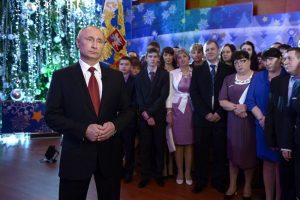
Image by Kremlin.ru
Putin is taking Russia on a path that rejects American-style mass-consuming, sexually liberated (not to say perverted) pop-culture in its entirety. In this he is aligning himself with only a handful of countries the likes of Iran, North Korea, and Cuba. The dominance of the American-led globalist model is such that it covers the entire globe and is responsible for over 90% of the global GDP and yet Putin has apparently decided to reject it. Is he oblivious to the dangers that await him and Russia on this path? A path in which he alone leads a normal, hitherto “non-pariah” nation of any real importance? I don’t think so. It seems to me that Putin is fully aware of the dangers inherent in his policy, but sees in it the only viable path for Russia to maintain its political and cultural independence. He sees the first cracks appearing in the globalists’ vision; more ethnic minorities than ever have gained their independence in the past quarter century than ever before and as the Catalan example shows, more are on the way. The US, under Trump’s leadership, is cautiously applying brakes to Soros’s runaway globalism rapidly turning into global totalitarianism. China and India, while economically the biggest beneficiaries of borderless globalism and hence the most dependent on it, are, to put it mildly, not the biggest fans of American pop-culture and the Globalists’ social justice by economic sanction agenda. Putin is betting that a Muscovy 2.0, one that is at once traditional and technologically advanced can be a “thing” in the world. In this bet, in the more remote future, he may yet be a natural ally of a post-Trumpian, more nativist America. In the short term however, Putin’s path is putting him on a collision course with the US, a collision the outcome of which will shape the world’s future for decades.


